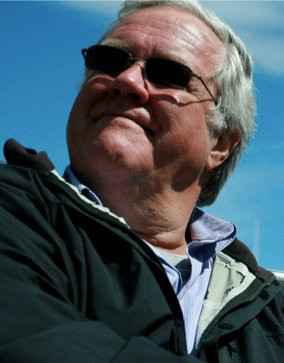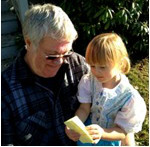 Jerry Nickles
Jerry Nickles
Professor of Medical Physics
“I think there is a bright future for PET.”
Family?
Lovely wife, just had our 50 year anniversary. Two great kids, and one absolutely perfect granddaughter (she would melt your heart).
What book is on your nightstand?
Believe it or not, I’m reading “Dead Man Walking,” getting ready for the opera and it is heavy reading; it’s not a finger-snapping musical!
What accomplishment are you most proud of?
My students – 20 good students. Also being in the black for 40 years, making isotopes at this place.
What other career could you see yourself in?
Probably a welder.
Hobbies?
A lot of outdoor things – traveling, bicycling, water sports.
In the Spotlight
Dr. Nickles is the quintessential physicist and uses this profound deep understanding of the physical laws of nature in all he undertakes. This is most evident in training the next generation of radiopharmaceutical scientists. All of his students learn every aspect of the imaging field from radionuclide production to cyclotron operation through to radiochemistry, PET camera operation and dynamic data collection, kinetic modeling and data interpretation; all of this is a hands-on experience.
What attracted you to the field of Medical Physics?
Back in the 50’s and 60’s John Cameron was pretty much the only medical physicist. Those who were lucky enough to work closely with him, including myself, gravitated into the field. John and I have shared a common past; we had the same Ph.D. advisor and we worked together in Brazil for some time. His influence, more than anything else, attracted me to the field.
My field is nuclear medical physics/nuclear medicine. I am a nuclear physicist by training. Nuclear medicine is now dominated by PET, which makes the best use of all branches of nuclear physics (isotope production, chemistry, detector development modeling). Working in this position was one of the most obvious slides over from being an accelerator jockey and measuring fundamental interactions to actually making use of the isotopes and the product of the nuclear reaction.
What is your current project, and what do you hope it will accomplish?
Working with basic scientists is what keeps things exciting and interesting for us. Some of the projects we are assisting with currently are working with Mary Schneider and providing her with neuroreceptor ligands for her primate study, Weibo Cai who is looking at everything that you can make, Brad [Christian] and a great deal of many other great researchers. We are providing raw material or finished radiotracers to very good researchers.
What are the challenges of working in Medical Physics? What can students learn from these challenges?
We are always underground, usually invisible. You have to learn to smile and hand the dishes off to the diner window and the customer. Some of the other challenges are fiscal; the equipment is outrageously expensive (cyclotrons, hot cells, robots), and if we did nothing – no one wanted anything that we did – we still have to keep this whole thing going. So there is this fixed cost that no one seems to quite have figured out when they’re asking us to make something. We have to carry a rather heavy burden of the fiscal load that doesn’t get taken care of on a per dose basis. We’ve managed to take on this challenge by reaching out serving about 30 different labs across the country, and working with some large collaborative labs keeps us afloat.
I’ve had 20 or so Ph.D. students here and what they take away from here is the set of skills to do anything and everything that they need to do. A good set of skills, a good set of hands, and they are sought after because of that.
What’s the best advice you’ve ever received? What advice would you give to students?
John Cameron had a number of aphorisms, but one that is hard to interpret until you finally understand John and what he is talking about is, “If it’s worth doing, it’s worth doing badly.” What he means is, to push where it’s soft. Don’t worry about adding one more digit of precision to some uninteresting part of science. It’s not what we do here. We make measurements, and they are rough. Might be off by a measurement of 20% or off or a factor of 2, but if it’s important, we can do it badly, and we do.
To students: “Don’t become a doctor’s flunky.” Although that probably won’t go over so well!
What do you think is the future of medical physics?
I think that cardiology will come back and realize that PET scanning of the ailing heart has a lot of diagnostic power. Clinical medicine will continue to embrace PET, and its use in fundamental research/basic research is assured. What we do shows the biochemical pathways, not morphology, not pretty pictures-we’re talking about chemistry and mathematics. I think there is a bright future for PET.
If you were awarded a million-dollar research grant, what would you do with it?
We are pretty well equipped for what we are doing right now, so I would hire a bunch of students who knew what they were doing and knew how to get their hands dirty, and support them by putting them on a good pathway toward their Ph.D.

